Ok, here's another update from my end.
The second coat of rust paint dried overnight on Saturday and I got back at it Sunday morning. First I did a dry fit check of the new butterfly gasket around the edge of the skimmer hole. It lined up well and the screw holes in the liner still lined up with the screw holes in the wall (i.e. the liner did not shift overnight).:
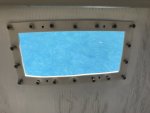
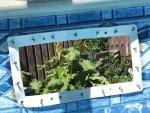
I then proceeded to install the skimmer in place. As I got towards the end of tightening the faceplate screws, I was looking along the edge of the faceplate and I could again see that the gasket was bulging out the side. The faceplate I have for this skimmer has a rounded 90 degree corner all along the inside edge which is supposed to cover the edge of the gasket along the inside of the opening - I wish I had taken a picture of it to share with you but I didn't. Anyway, it seems the inner dimension of the faceplate opening did not account for the added padding along that edge contributed by the butterfly gasket (almost as if it was designed for non-butterfly gasket). Furthermore, the size of the opening in the pool wall also didn't account for the butterfly gasket. The net result was that, instead of the flat part of the faceplate sitting flush on the gasket and the corner of the faceplate rounding the inner edge of the gasket, I was ending up with the inner corner of the faceplate pressing into the flat portion of the gasket causing it to bulge and causing less than ideal contact against the surface of the faceplate. I thought for sure that must have been the original issue that caused the leak in the first place.
So, I took everything apart and removed the gasket. With my dremel, I shaved about 0.05" of material along the edge of the opening in the pool wall - just enough so that I could tightly press the faceplate over the gasket and have the inner corner of the of the faceplate come around the inner border of the gasket and fit within the wall hole. It was still a very tight fit so it took some careful pressing and a few retries but I did get it to fit finally.
After tightening everything with the skimmer mounted, I could see no bulging gasket along the inner edge of the skimmer mouth. I took a couple of shots of it here:
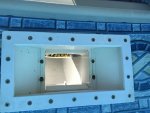
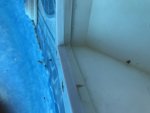
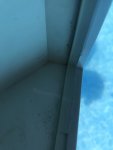
As I said, I really thought the ill-fitting gasket and faceplate had been the source of the original problem and I was feeling a whole lot better about how it was fitting this time around. With everything tightened up, I went ahead and started re-filling the pool. When it was full again, I started the system back up and ran the system overnight to get some circulation and filtration going.
Unfortunately, when I woke up this morning to get ready for work I found that the level dropped. I didn't take a good measurement but I think I had lost a good 3/4 inch maybe more during the overnight hours. And today after work I found that it dropped a bit more as compared to the morning. So, I'm clearly still losing water at roughly the same rate that I was before.
So now, I don't know what to think. Some options that come to mind include:
A. something isn't tight enough or lined up properly in my reinstallation
B. the original skimmer mount and/or faceplate are compromised and I should have replaced them as part of this job.
C. I've been barking up the wrong tree this whole time and the leak is actually coming from somewhere else altogether.
I really don't like all of the guesswork involved here especially since each trial and error attempt takes so much time and effort to get through. I need a better test or measurement to give me a stronger signal that I'm actually working on the right area and not chasing after ghosts.
Should I try an ink test to hopefully see visually where the water is escaping? I've never tried one before so I don't know how effective they are. Any other thoughts on what I should try next? Again, my preference would be to do something that will give me better information on where the actual problem is coming from and then I can focus on that area and do whatever it takes to get it fixed.
Let me know.
Thanks,
Denis








